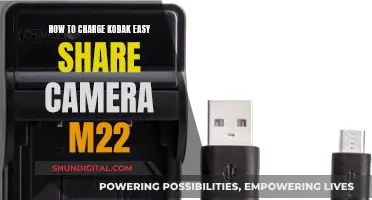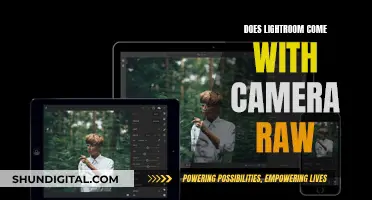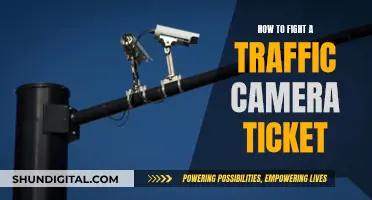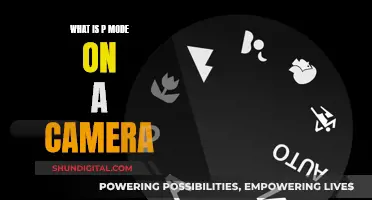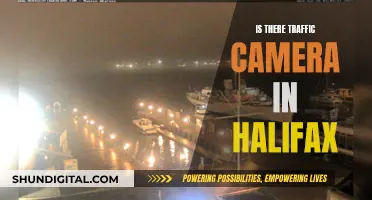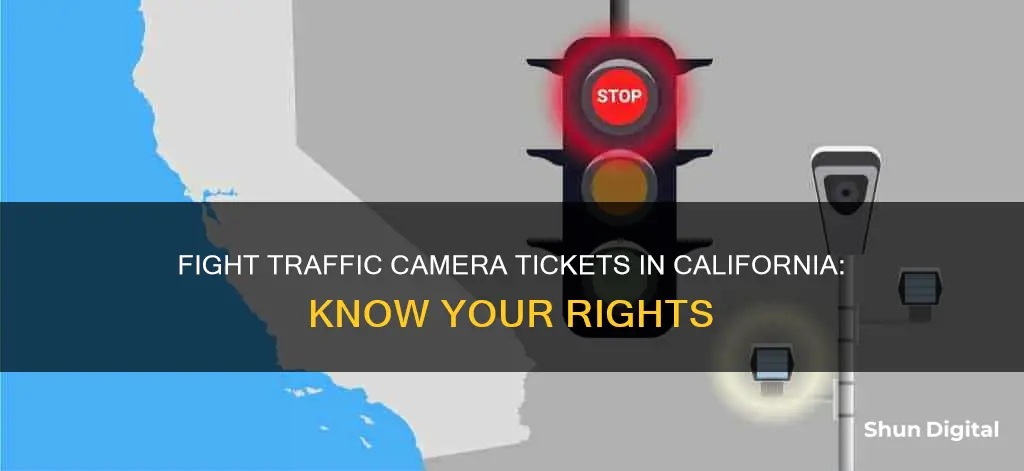
If you've received a traffic camera ticket in California, don't panic. There are several ways to contest it and you have a constitutional right to plead your innocence. First, examine your ticket and check the date, time, and location. Make sure that you were actually driving the car when the ticket was issued. Then, review the photos and check that your car is clearly visible, and that the photo shows a clear violation. If you weren't driving, submit an affidavit. Next, research the applicable law and look for cases in your city or county about traffic cameras. You can also research potential defenses, such as arguing that warning signs were obscured or not present, or that you were speeding out of necessity. Finally, you can plead not guilty by mail, online, or in court, and request a formal hearing.
| Characteristics | Values |
|---|---|
| Ticket Delivery | A ticket will be mailed to the registered owner of the car within 15 days of the incident. |
| Ticket Contents | Information about the incident, instructions on how to pay the fine or contest the ticket, and a link to view photo/video evidence. |
| Pleading | Plead not guilty by the deadline (typically 30 days) if you want to dispute the ticket. |
| Arraignment | A formal reading of the charges where you must enter your plea. |
| Evidence | Request photos/videos, maintenance records, and information on the camera system from law enforcement. |
| Defence | Argue that the camera system was faulty, the photo/video evidence is unclear, or that you were driving out of necessity. |
| Hearing | Present your case and evidence in court. |
What You'll Learn

Check if you were driving
If you've received a traffic ticket in California, the first thing to do is to check if you were driving. Here's a step-by-step guide on how to do that:
Step 1: Read Your Citation Carefully
Your citation will provide information about the incident, including the date, time, and location. It will also include instructions on how to pay the fine or contest the ticket. Check the date and time of the incident and review your schedule to determine if you were driving your car.
Step 2: Request Photographs or Videos
Red light cameras typically capture photos or videos of your license plate as you pass through the intersection. These photos and videos are usually available online. Visit the website listed on your citation to view them. If they're not available online, contact the law enforcement agency that issued the citation to request this evidence.
Step 3: Check if You Were Driving
Examine the photos and videos carefully to determine if you were the one driving the vehicle at the time of the incident. If you weren't, you're not responsible for paying the ticket. The registered owner of the vehicle will receive the citation, but they can contest it if they weren't driving.
Step 4: Submit an Affidavit if You Weren't Driving
Your citation should include an affidavit form that you can use to declare that you weren't driving. Provide the name and address of the person who was driving so that the citation can be redirected to them. If you don't have their driver's license number, leave that section blank, and the law enforcement agency will look it up. Submitting this form voluntarily can help clear your name, and the court will drop the ticket if they can't identify the driver.
Remember, it's essential to be honest during this process. Do not claim that you weren't driving if you actually were, as this would be considered perjury.
Monthly Fees for Cellular Cameras: What's the Deal?
You may want to see also

Examine the photos
When contesting a red-light camera ticket in California, it is important to first check if the citation meets basic requirements. These include whether your car is clearly visible, your license plate is legible, and the driver is identifiable. If any of these are missing, you can submit an affidavit highlighting deficiencies.
You should also request photographs or videos of the incident. The red light cameras produce photos of your license plate as you are passing through the intersection, and may also have a video of your car driving through. These photos and videos are typically available online, but if not, you can request them from the law enforcement agency that issued your citation.
Once you have the photos, examine them carefully. Sometimes, the quality of the photo taken by the red light camera may be poor enough to get the ticket dismissed. For example, bad weather conditions may blur the driver’s face. If the photo does not show a clear violation, you may be able to get the ticket dismissed.
The Polaroid SX-70 Land Camera: A 70s Innovation
You may want to see also

Plead not guilty
If you receive a traffic ticket for an infraction in California, you have the option to either pay the fine or contest the ticket in court. If you choose to contest the ticket, you can plead "not guilty". Pleading not guilty means that you do not admit guilt and you wish to contest the ticket in court. If you plead not guilty, a trial will be scheduled, and you will have the opportunity to present your case to a judge or jury.
- Review your citation carefully: Check the date, time, and location of the incident. Also, check if the citation includes a link to photos or videos of the incident. Review the images and videos to understand the situation better.
- Gather evidence: If you believe that there were mitigating circumstances, gather evidence to support your claim. For example, if you recall the yellow light being unusually short, time the yellow light interval at the intersection and compare it with the required time specified in the California Manual on Uniform Traffic Control Devices. You can download a copy of this manual online.
- Identify possible violations by the authorities: Check if there were any violations by the authorities, such as a lack of proper warning signs or improper calibration of the red-light camera. Ensure that warning signs are posted within 200 feet of the intersection and are clearly visible to oncoming traffic.
- Submit an affidavit if you weren't driving: If someone else was driving your vehicle when the incident occurred, you can submit an affidavit stating that. Provide the name and address of the person driving so that the citation can be redirected to them.
- Prepare your defence: Organise your documents and evidence for the trial. You may introduce physical evidence and even call witnesses to support your case.
- Plead not guilty at your arraignment: Your citation will include a date for your arraignment or pre-trial. At the arraignment, you will be expected to enter your plea. Fill out the necessary forms or write a letter to plead not guilty. Some counties may also allow you to enter your plea online.
- Attend your trial: Arrive at the courthouse early and be prepared to present your case to the judge. Speak clearly and coherently, sticking to the facts of your defence. Address the judge with respect and wait for them to finish speaking before continuing.
Remember, it is important to carefully consider your options before deciding to plead not guilty. If you are unsure, you may want to seek legal advice from an attorney or a legal aid organisation.
Reviving Camera Batteries: Simple Tricks to Try
You may want to see also

Challenge the admissibility of the photo
Challenging the admissibility of a photo taken by a traffic camera is one way to dispute a traffic camera ticket in California. Here are some steps you can take to challenge the admissibility of the photo:
- Check the photo for clarity: If the photo is blurry and your license plate is not clearly visible, this may be a valid defence.
- Assert your right to confront witnesses: Under the Sixth Amendment of the US Constitution, you have the right to cross-examine witnesses. Unless a witness appears who maintains the record and system associated with the camera, you do not have the opportunity to confront them.
- Dispute the authenticity of the photograph: If no one from the company that maintains the camera shows up to testify, you can object to the use of the photographs on the grounds of lack of foundation. The prosecution must present evidence that the camera, the system connecting it to the traffic light, and the traffic light itself were functioning properly.
- Attack the lack of evidence: If the photos are clear and the judge allows them, but none of them clearly show you driving, you can argue that the prosecution cannot prove it was you driving the car.
- Raise other possible defences: For example, if your attack on the camera is unsuccessful and the photos are admitted as evidence, you can still raise other defences. For instance, some states recognize a necessity defence for speeding, so if you were driving to the hospital in a rush, you might have a defence.
Polaroid's 1999 Gift for Kids: The Instant Fun Camera
You may want to see also

Argue the camera was faulty
Arguing that a traffic camera was faulty is one of the most common ways to contest a traffic camera ticket in California. Here's how to do it:
Step 1: Check the Evidence
First, check the photos or videos included with your citation. If the photos are unclear or don't show you driving, this can be used as evidence that the camera was faulty.
Step 2: Research the Camera's Maintenance
Next, research the maintenance of the camera. California law requires automatic enforcement systems to be regularly calibrated and inspected. If the camera hadn't been inspected or failed calibration when you received the ticket, you may be able to get the ticket dismissed. You can request this information from the relevant law enforcement agency.
Step 3: Plead Not Guilty
Enter a plea of "not guilty" at your arraignment. This is a formal reading of the charges against you, where you must indicate how you intend to plead. You must plead not guilty if you want to contest the ticket.
Step 4: Organise Your Evidence
Gather any evidence that the camera was faulty, including your research on its maintenance, and organise it for your trial. You may also want to call witnesses, such as someone who was in the car with you and can testify that the yellow light was unusually short.
Step 5: Present Your Case
When you attend your trial, present your evidence and explain to the judge why you shouldn't have to pay the fine. Speak clearly and logically, and stick to the facts.
Step 6: Receive the Court's Decision
After you've presented your case, the judge will decide whether you're guilty or not guilty. If you're found guilty, you'll typically have to pay the fine immediately. If you're found not guilty, your deposit will be returned and the ticket will be dismissed.
Benz-Gant Camera: Battery-Operated or Not?
You may want to see also
Frequently asked questions
First, check the date, time, and location of the ticket. Make sure that you were actually driving the car when the ticket was issued. If you weren't, you can submit an affidavit form to provide the name and address of the person who was driving.
You must plead not guilty if you want to dispute the ticket. You can do this by mail, online, or in person at an arraignment. You'll then need to build a defence, which may include checking that warning signs are present and visible at the intersection, timing the yellow light interval, and requesting information on the maintenance of the camera system.
If you are found guilty, you will usually be expected to pay the fine immediately. However, you can appeal the decision. While it isn't necessary to have an attorney for this, it may be beneficial to have one on your side.
Yes, there are online resources and tools that can help you challenge a ticket without the need for an attorney. These may include step-by-step guides and toolkits to help you build a solid defence.


